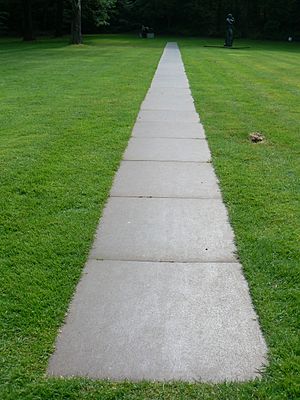Carl Andre facts for kids
Quick facts for kids
Carl Andre
|
|
|---|---|
| Born | September 16, 1935 Quincy, Massachusetts, U.S.
|
| Died | January 24, 2024 (aged 88) New York City, U.S.
|
| Education | Phillips Academy |
| Known for | Sculpture |
|
Notable work
|
Equivalent VIII Lever |
| Movement | Minimalism |
| Spouse(s) | |

Carl Andre (born September 16, 1935 – died January 24, 2024) was an American artist. He was known for his minimalist sculptures. These artworks often used simple shapes and were arranged in straight lines or grids.
His sculptures varied greatly in size. Some were large public artworks, like Stone Field Sculpture in Hartford, Connecticut. Others were big pieces meant for indoor floors, such as 144 Magnesium Square. He also made smaller, more personal works.
Andre was married to artist Ana Mendieta. She sadly died in 1985 after falling from their apartment window. This event led to much discussion and protests at his art shows. People who supported Mendieta often asked, "Where is Ana Mendieta?" at his exhibitions. Carl Andre passed away in New York City in 2024 at the age of 88.
Contents
Early Life and Art Beginnings
Carl Andre was born in Quincy, Massachusetts, on September 16, 1935. He went to school in Quincy. Later, he studied art at Phillips Academy in Andover, Massachusetts, from 1951 to 1953.
While at Phillips Academy, he became good friends with Hollis Frampton. Hollis helped Carl think about art in new ways. He also introduced Carl to other artists.
After serving in the U.S. Army from 1955 to 1956, Carl moved to New York City. There, he met Constantin Brâncuși, a famous sculptor. Through Brâncuși, Carl reconnected with Frank Stella, a former classmate. Carl and Frank shared a studio from 1958 to 1960.
Carl Andre's Artworks
How His Art Changed
Carl Andre looked up to Brâncuși for his early wooden sculptures. But talking with Frank Stella changed his ideas about space and shapes. While they shared a studio, Carl started making "cut" sculptures from wood. Frank Stella once told him that even the pieces of wood cut off were also sculpture!
From 1960 to 1964, Carl Andre worked on a railroad. He was a freight brakeman and conductor. This experience with hard work and the organized nature of trains later influenced his art. He even often wore work clothes, like overalls, to fancy events.
During this time, Carl mostly focused on writing. He didn't make much sculpture. His poetry was later published in a book called 12 Dialogues. In this book, he and Hollis Frampton wrote poems and essays back and forth. Carl's unique poetry has been shown in museums in the United States and Europe.
Famous Works and Exhibitions
In 1965, Carl Andre had his first public art show. It was called Shape and Structure. In the late 1960s, a collector from Germany bought three of his major works. These works are now part of the Museum für Moderne Kunst in Frankfurt.
In 1969, Carl Andre helped start the Art Workers Coalition. This group worked to support artists' rights. In 1970, he had a special solo exhibition at the Solomon R. Guggenheim Museum in New York.
Equivalent VIII and the "Bricks Controversy"
In 1972, the Tate Gallery in Britain bought Carl Andre's artwork Equivalent VIII. This piece is made of 120 firebricks arranged on the floor.
The artwork was shown many times without any issues. But in 1976, it became very famous and caused a big debate. This happened after an article about it appeared in The Sunday Times. Someone even poured blue food dye on it! This event, known as the "Bricks controversy," became a famous public discussion in Britain about what modern art is.
Lever
Another important work by Carl Andre is Lever. It is a single line of 137 firebricks. This artwork simply divides a space as the bricks lie flat on the floor. When Lever was shown in 1966 at the Primary Structures exhibition, it brought Carl Andre a lot of recognition.
His Relationship with Ana Mendieta
Carl Andre met artist Ana Mendieta in 1979. They became friends through other artists. Carl and Ana got married in 1985.
Sadly, Ana Mendieta died in 1985 after falling from their apartment window. This event made Carl Andre a very controversial figure. Museums that showed his art often faced protests from people who supported Ana Mendieta. For example, in 2017, protestors at an exhibition in Los Angeles handed out postcards. These postcards asked, "Carl Andre is at MOCA Geffen. ¿Dónde está Ana Mendieta?" This means "Where is Ana Mendieta?" in Spanish.
Books by Carl Andre
- Quincy, 1973: This book by Carl Andre features photos of landscapes and monuments in his hometown of Quincy, Massachusetts.
- America Drill, 2003: This is a special limited edition book.
Death
Carl Andre died on January 24, 2024.
See also
 In Spanish: Carl Andre para niños
In Spanish: Carl Andre para niños



